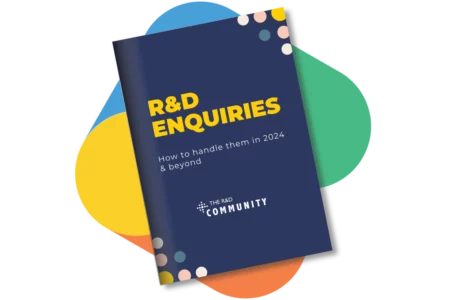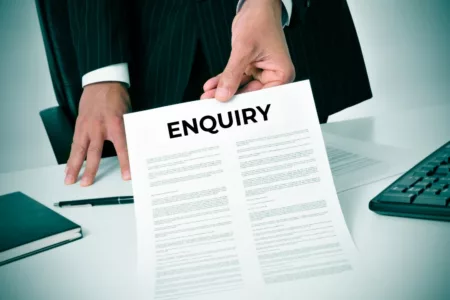Now, however, that even-handed and helpful approach seems to have been replaced with one that is far more sceptical and aggressive. HMRC seems to be taking an extremely tough line in all its R&D compliance checks, treating even well-prepared claims as harshly as any other.
This means that while defending an R&D enquiry has always been a skilled and delicate task, it’s now far more difficult than it used to be. Success now relies on the quality of the evidence you can gather to support your clients’ projects. In this article, we describe the type of questions and tactics you might see from HMRC and suggest how to deal with them.
What triggers a Compliance Check?
1. Long reports
Some anecdotal evidence is arising that suggests that HMRC is time-boxing its risk reviews to 30 minutes. If a report can’t be reviewed in that time, usually because it’s longer than 5-6 pages, it may be classed as medium risk – simply because the case worker wasn’t able to finish it within the allotted review time.
2. Using hyperbole or overly elaborate language
In an attempt to make their claims sound stronger, some advisors resort to hyperbole. They’ll use words like ‘extreme’ or ‘intense’, even when that stretches the reader’s credulity e.g. “The fabric had to be able to withstand the extreme conditions found within the passenger bus.” Really? That, combined with using ten words when one would do, may give HMRC the impression that someone’s working hard to pull the wool over their eyes – giving them an incentive to open an enquiry.
3. Submission documents omit key details
The additional information form needs to concisely answer the questions raised by HMRC. If the narrative is incomplete or lacks clarity, it won’t give HMRC enough information to be able to determine whether R&D was conducted.
A common issue is that advisors don’t frame the context of the project with reference to an overall limitation in knowledge or capability in science or technology. This can make the project appear company-specific and makes it much harder for HMRC to see if the advance was genuine.
4. Obvious errors
Some mistakes jump off the page and are so glaring that they call the credibility of the advisor (and their understanding of the guidance) into question. We’ve written about these before in our free Red Flag Checklist.
5. Sector and website
If HMRC look at the company’s SIC code and see something like ‘Wholesaler’ or ‘Reseller’, that might be enough for them to think “There’s surely not R&D in that”. They’ll probably cross-check the SIC code on Companies House with the company’s website – and not having a website at all may give the impression that it isn’t a particularly high-tech company.
6. Random selection
HMRC have confirmed that they are continuing to select claims at random for enquiry, so that they can assess the overall level of fraud and error in the scheme. So even if you avoid all the pitfalls listed, you may still have to deal with an enquiry.
This is far from a complete list, but as you can see, there are quite a few factors at play. It’s likely that HMRC makes decisions on which claims to select based on a combination of these. So, for example, if a claim has a long report that’s poorly structured, is written in an obfuscatory way with lots of hyperbole and pseudo-science, and contains statements that reveal the advisor to have a shallow or incorrect understanding of the scheme, it’s probably more likely to be pulled out the pile and marked ‘For Enquiry’.
What can you expect from an R&D enquiry?
The main tenet of an enquiry is lots of work, unfortunately. In general, the first phase of the compliance check is where HMRC want to gather more information, and expand their view of the claim and the project. HMRC will start with a single round of questions. The first round of questions is usually fairly extensive and generic. Typically you’ll get a letter asking for details of the project, names of staff, subcontractors and workers involved in the project and their activities and evidence to support the costs included in the claim. Then, if they have concerns about your first responses, they’ll ask further rounds of questions – and this can lead to a situation where you might end up with 50-60 open questions to deal with.
Your goal is to avoid this! If you can respond with relevant and clear information to the first round, and HMRC is satisfied with the information you’ve provided, they may move on to discussing the costs in more detail. If the case worker is happy that at least some R&D has taken place, they will then want to make sure that it’s been accurately quantified.
There are usually three key challenges in an R&D enquiry:
Getting your client onboard
Your job will be so much easier if your client is engaged, knowledgeable in their subject area, and keen to work with you to defend their claim. In contrast, if your client shrugs and sits back, expecting you to deal with everything on their behalf, you’re both going to have a rocky ride – and very probably not get a great result. It is the assessment and evidence provided by the client’s competent professional that HMRC will be interested in, and without this engagement, it is likely to be almost impossible to respond fully to HMRC’s questions. Read our guide How to Handle an R&D Enquiry for more on this.
Presenting the information in an effective way
It’s very much like being back at school, where the teacher reminded us to “READ the question!”. Unless you give HMRC exactly what they’ve asked for, they’re likely to come back with yet more questions. Generally, you want to stick strictly to what they asked and to keep your answers as concise and clear as possible.
Convincing HMRC that the claim isn’t high risk
It isn’t easy to change HMRC’s mind about a claim, given their default attitude of ‘Nothing here is eligible!’ Still, how you respond and the information you provide can help to reassure them that you and the client have a good working knowledge of the guidance, that the boundaries of R&D have been set appropriately, and that you and your client are being proactive in helping them resolve the compliance check.
What specific questions are you likely to get?
Sometimes people are surprised to submit a full narrative describing the projects, only to get a very general list of questions back from HMRC. Don’t be – this seems to be common practice. In fact, when queried why its workers were asking questions that had been answered in the provided report, HMRC said that a) it still had some training issues with its team and b) many of the reports provided aren’t well-written or well-structured, so it’s easier for them to just start from scratch. Given the number of enquiries being opened at the moment, our guess is that it’s just faster for HMRC to open a compliance check and send out a template letter.
Here’s the type of thing you can expect from their initial salvo:
For the Accounting Period Ending: e.g. 30 September 2020
- Detail of the number of Research & Development projects claimed for within the period.
- For each project:
- An explanation of the scientific or technological advance
- An explanation of the scientific or technological uncertainties involved in the project
- Detail of how and when the uncertainties were overcome
- Detail as to why the knowledge being sought was not readily deducible by a competent professional
- For each project:
- A breakdown and analysis of the qualifying expenditure claimed along with the steps taken to calculate the additional enhanced expenditure.
- For Qualifying expenditure on externally provided workers, the name of every individual included in the claim to relief, as well as a brief description of their role in the R&D projects). For each individual, you should include the total paid in the period, and the amount included in the claim for relief.
- For Sub-contractor payments, the name of every subcontractor included in the claim to relief, as well as a brief description of their role in the R&D process. For each, you should include the total paid in the period, and the amount included in the claim for relief.
- For any apportioned costs, the rationale and methodology used to come to this apportionment, with supporting evidence where available. If no apportionments have been made, please state this.
- Confirmation that all the amounts included above have been paid and incurred. Where payment is not a transfer of funds please indicate where this has occurred and why you believe the amounts satisfy the paid condition outlined in CIRD 82100.
- Any other information you feel would aid the enquiry.
Related: We have a dedicated section on the different questions HMRC might ask in our Enquiry Guide
This might look overwhelming, but actually, they’re just looking for the basics at this point. Each question has a different purpose.
First, they’re trying to work out whether the company has:
- claimed for (and submitted descriptions of) a defined number of projects OR
- has claimed for an unspecified number of projects, using a few specific projects as examples.
This might look overwhelming, but actually, they’re just looking for the basics at this point. Although there’s a lot of information requested, these should all be points that you discussed when first compiling the claim.
First, they’re trying to verify that the company has claimed for a defined number of projects, which should correspond to the information given on the additional information form. They are also trying to establish that the boundaries of each project have been correctly defined and are within the scope of R&D for tax purposes.
Requesting a project timeline makes it easier for HMRC to asses project boundaries, ensuring that any commercial activities pre- or post- R&D have been excluded from the claim.
The second thing that HMRC is trying to do is ascertain whether the definition of R&D has been met for each project. This depends on two things – that an advance in technology was made relative to the baseline level of technology, and secondly, that achieving that advance required the resolution of ‘technological uncertainty’. How you answer these questions will typically give HMRC a lot of information about your level of understanding of the guidance.
Lastly, they’re trying to verify that the right costs have been claimed, and that any apportionments were reasonable.
Ok, we’ve done that. What comes next?
The next steps depend on the quality of your answers to the first round. If you’ve done well with those, HMRC will probably indicate a few areas in which it would like to see some amendments made to the claim. Essentially, if they’re content that at least some R&D took place, the rest of the enquiry should be about tidying up the loose ends.
Unfortunately, this seems to be relatively rare, and it’s more likely that you’ll get a second round of questions. At this stage, they are likely to relate to the evidence you have submitted to support the claim, with HMRC still sceptical that any of the client’s claim involves R&D.
You’ll typically see HMRC to refer to the evidence you’ve presented to support the claim and tie this to a particular paragraph in the DSIT guidelines that supports the rejection or invalidation of the evidence.
In responding at this stage, you’ll need to work closely with the competent professional on the claim. They will need to assess each of these assertions carefully. It is possible for HMRC to mistake the nature of the project or project activities, or to draw an invalid conclusion based on a single piece of evidence rather that assessing the evidence as a whole. Your response to these second-round questions will depend on the relevance and quality of the evidence you can provide.
How does an enquiry resolve?
If you can assuage HMRC’s main concerns about the claim, their questions will peter out or become easier to answer.
Unfortunately, in many cases, this doesn’t happen. Here are some common outcomes:
- HMRC asks an unreasonable number of questions and then declares that “Insufficient evidence has been provided that R&D took place, so we’re denying the claim in its entirety.”
- HMRC asks to see contracts between your client and its clients and then declares that “Your (SME) client was undertaking R&D as a subcontractor to other SMEs, therefore it cannot claim under the SME scheme”.
- HMRC declares that the company’s staff were not suitably qualified or experienced in the area of the advance, so cannot be considered Competent Professionals;
- HMRC opines that the work appears to be ‘readily deducible’ to a Competent Professional, so no R&D took place.
There are many arguments that HMRC can make against work being R&D, and these are only some of the most common.
So, if you reach this point, where you believe that your client qualifies, but HMRC takes an opposing and entrenched position, where can you go from there?
- Option 1: Ask for a Statutory Review. In a Statutory Review, your case will be reviewed not by your case worker, but by someone at HMRC who was not involved in the original decision.
- Option 2: Ask for Alternative Dispute Resolution (ADR). In this, an HMRC mediator who has been trained in mediation skills and techniques will work with you and the HMRC officer dealing with your case. Note the availability of ADR is at HMRC’s discretion, and you are not able to request ADR if you have already appealed the decision and asked for a Statutory Review and this has not yet been completed. ADR is particularly useful in cases where HMRC hasn’t agreed evidence you’ve given to them, or where the dispute stems from a fundamental misunderstanding of the facts. You can ask HMRC for access to the ADR process before a decision to reject the claim is reached.
- Option 3: Appeal to the Tax Tribunal. The First-tier Tribunal (Tax) sits independently of the Government and HMRC. It has found against HMRC in the past, most recently in Quinn (London) Ltd. These are high profile cases, with the detailed notes and decisions made public, so tend to be the option of last resort. You can appeal to the tribunal within 30 days of when HMRC has made a decision to reject a claim, or 30 days following a Statutory Review decision. You cannot appeal to Tribunal if you have requested a Statutory Review and this has not been concluded.
It’s not uncommon to bring in some support at this stage – when things have gone beyond a simple question and response. We have a branch of our claim support services dedicated to enquiries – read more about how we can help.
General principles in dealing with HMRC’s compliance checks
Be nice to your case worker
Unfortunately, the way that HMRC is now working makes it far hard to establish a good working relationship with an Inspector or case worker. Many enquiry letters don’t give you a contact name or phone number; all they have is a general email address. That makes it hard to know who you’re dealing with (and in fact, it could be multiple people).
Manage client expectations on timeline and success
Be open and clear with your client about how much work is involved in the process and how long it’s likely to take. If your client is realistic about the process, they’re less likely to get frustrated and despondent as you go through it.
Treat every enquiry as a learning exercise
Enquiries are time-consuming and expensive, so you might as well get as much value from them as you can. Take a note of the questions they’re asking and see if you can work out whether anything in the original claim could have prompted that question. Secondly, think about your claim process. Is there anything you could change to prevent that type of question arising again from HMRC?
Will our client get a penalty if they lose their compliance check?
It’s possible, but there are things you can do to make this less likely. Essentially, if there is a difference in the claim before and after the compliance check, HMRC will deem the claim to have contained an ‘error’. Sometimes this will be very clear cut, like an invoice that’s been included when it shouldn’t have been, but other times it will be much more subjective. For example, whether a technical problem was ‘uncertain’, ‘unknown’ or ‘readily deducible’ is all very subjective – yet the fact is that if HMRC holds a different subjective opinion, that can constitute an ‘error’ in your client’s claim! It’s an integral part of the compliance check process for HMRC to assess for penalties once they have made a decision. Whether a penalty will be applied depends on the facts of each case and whether reasonable care was taken by your client when compiling the claim.
The ways that penalties are applied are shown in the table underneath. The percentages relate to the tax that was in danger of not being paid due to the error.
| Type of behaviour | Unprompted | Prompted |
|---|---|---|
| Reasonable care | No penalty | No penalty |
| Careless | 0-30% | 15-30% |
| Deliberate | 20-70% | 35-70% |
| Deliberate and concealed | 30-100% | 50-100% |
This means that if your client can show that they took ‘reasonable care’ in preparing their claim, they should avoid a penalty. And if they do get slapped with a penalty, HMRC take their behaviour during the enquiry into account when deciding whether the penalty should be discounted. In their factsheet CC/FS7a, they give examples of the type of assistance you may have given during the compliance check, and break these up into three categories, which lead to different discounts.
- For “telling”, HMRC will apply a discount of 30%
- For “helping”, HMRC will apply a discount of 40% and
- For “giving” (access to records), HMRC will apply a discount of 30%.
Being helpful and proactive during an enquiry will always be to your client’s benefit, even if HMRC doesn’t agree that they are entitled to R&D tax relief.
What can you do to avoid future enquiries?
Most enquiries aren’t opened because of a complex issue. Instead, they tend to arise when HMRC has significant concerns about a client’s understanding of the definition of R&D.
This means that one of the best ways to avoid future enquiries is to make sure that your team has a current – and consistent – understanding of:
- How HMRC defines R&D for tax purposes
- How to explain the eligibility criteria to your clients in a way that’s clear and easy to understand
- How to extract the right information from your client, and
- How to clearly structure this information when presenting it to HMRC.
These are all concepts that you can work through in detail in our course – Explaining Eligibility. With a better knowledge of the scheme and its constraints, you’ll more reliably build strong, defensible claims. It’s included as part of membership, but you can also buy it as a standalone course.





